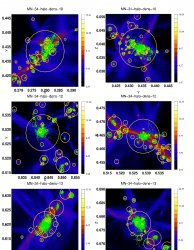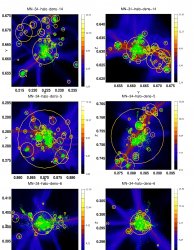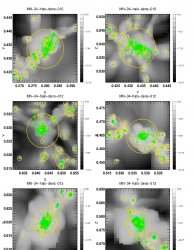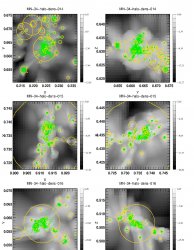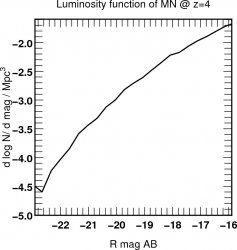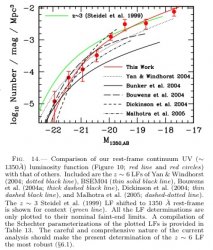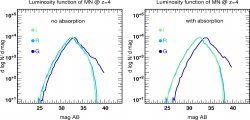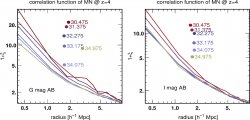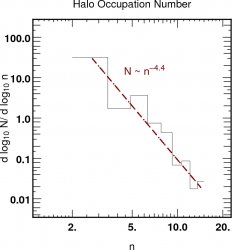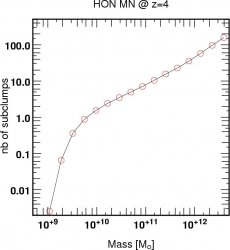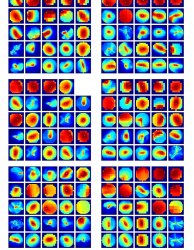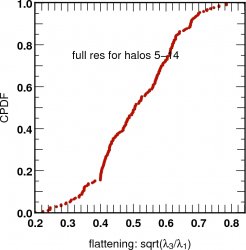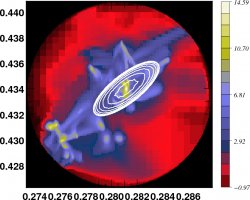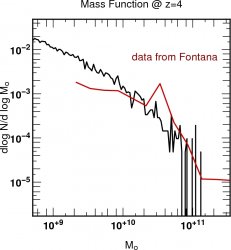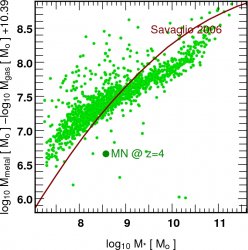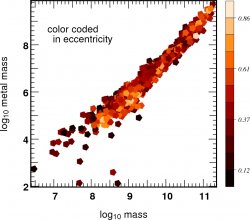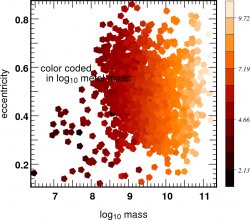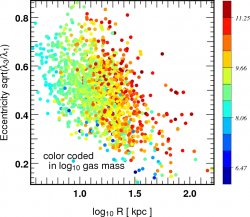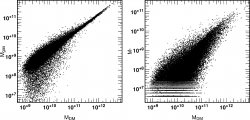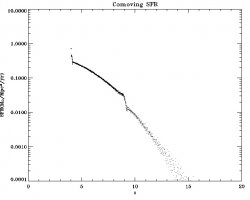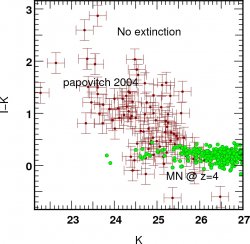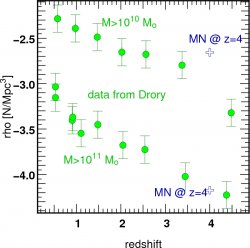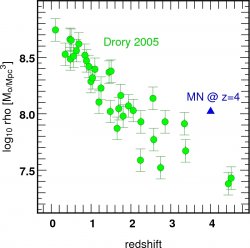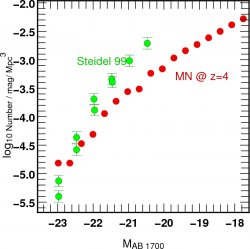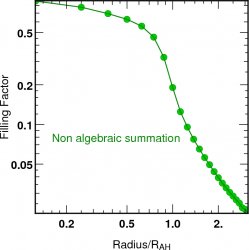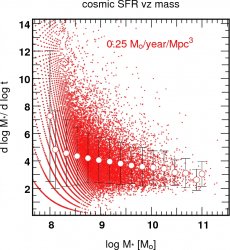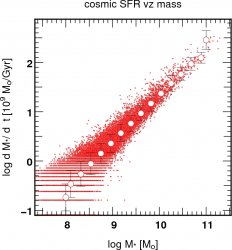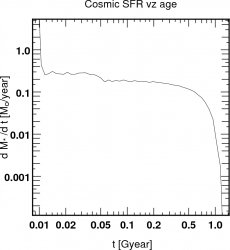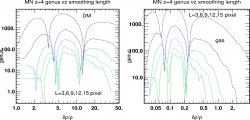
The site's hierarchy
Navigation
| M | T | W | T | F | S | S |
|---|---|---|---|---|---|---|
| 23 | 24 | 25 | 26 | 27 | 28 | 1 |
| 2 | 3 | 4 | 5 | 6 | 7 | 8 |
| 9 | 10 | 11 | 12 | 13 | 14 | 15 |
| 16 | 17 | 18 | 19 | 20 | 21 | 22 |
| 23 | 24 | 25 | 26 | 27 | 28 | 29 |
| 30 | 31 | 1 | 2 | 3 | 4 | 5 |
- Les premiers zoom de galaxies sont accessibles
- Le halo FOF 6133 de la boite Horizon L et le halo FOF 544 de Horizon S ont été resimulés avec plusieurs techniques de zoom. Il est important que chaque "zoomer" valide sa méthode, avant de lancer une campagne de zoom sur un plus grand cataloque.
- Les données de la simulation Mare Nostrum sont disponibles
- 34 snapshots jusqu’à z=4 sont accessibles sur horizon3 et sur le serveur de fichiers de l’IDRIS à la collaboration Horizon.
- Méso Machine HPC1 opérationnelle
- Depuis le 23 Octobre 2005, la Méso machine du site horizon est operationnelle. Elle correspond à 3 quadriprocesseurs avec chacun 64 Giga de RAM reliés par infiniband, ainsi qu’un access conséquent (sur une base de projet dédié) au reste de la ferme). Son acces est ouvert a toute personne de la collaboration ayant acces à la minigrille et qui en fait la demande a admin-minigrille
- http://
- Workshop Horizon le 14 et 15 novembre 2005
- Il aura lieu à Paris les 14 et 15 novembre 2005 (prévoir une nuit sur place). L’enregistrement est ouvert dans la rubrique "meeting!"
- http://
Structure identification on MN 34
In colour the gas density, in green the stars, in yellow the leaves of DM + core of mother with Dylan’s post treatment.
In grey the metal density, in green the stars, in yellow the leaves of DM + core of mother with Dylan’s post treatment.
The corresponding dark matter adaphop structures are available on the FTP server of the HORIZON collaboration: HORIZON-FTP
3 files are found there
![]() MN-34-adaphop.nod : all clumps in adaphop format
MN-34-adaphop.nod : all clumps in adaphop format
![]() MN-34-leaves-with-stars.nod : all galaxy clumps
MN-34-leaves-with-stars.nod : all galaxy clumps
![]() MN-34-star.nod : clumps in the star catalog
MN-34-star.nod : clumps in the star catalog
The second catalog corresponds to a post treatment of the first, following the prescription described in Sort Nodes, and a selection based the fact that each clump contains at least one star. It is our GALAXY reference catalog.
CAVEATS: the dark matter adaphop catalog and its sequels was produced by segments of 1/8th of the simulation. A reordering and overlapping recovery of the full catalog in in progress. It was shown for the FOF catalog that the difference in treatment was minimal (0.2 %).
The corresponding spectra (73k Galaxies) produced with PEGASE2 are available on the FTP server of the HORIZON collaboration: HORIZON-FTP
5 files are found there
![]() MN-34-gal-spectra.dat (500 megas)
MN-34-gal-spectra.dat (500 megas)
![]() MN-34-gal-spectra.txt
MN-34-gal-spectra.txt
![]() MN-34-gal-spectra-wavelength.txt
MN-34-gal-spectra-wavelength.txt
![]() MN-34-gal-color.dat
MN-34-gal-color.dat
![]() MN-34-gal-color.txt
MN-34-gal-color.txt
the first is in totor format (see below) it contains
| x y z [box fraction] | m [solarM] | age [Myr] | log10 z [mass fraction] | flux [Erg/s/solar M/cm^2 ] |
the second is the beginning of the first in ascii as a check
the third is the corresponding wavelength in Angstrom.
the forth is the table of colours in various filters relevant for high redshift objects
| x y z [box fraction] | m [solarM] | age [Myr] | log10 z [mass fraction] | observed Magnitude in G R I z K IRAC-3.6 IRAC-8.0 |
The last is the first 80 lines of the fourth as a check
The following Fortran example shows how to read such files:
As a check we produced the following color diagrams from the above spectra:

Only half of the box is processed.
This figure can be reproduced
qualitatively from the catalogs given
on the ftp server
|
Quantitativement, la Distribution ci dessous semble en bon accord avec les donnees publiees par Bowens et al. 2006 pour des galaxies à z 6
One and two points statistics
Once the colours have been computed, it is possible to look at one and two points statistics with the catalogs.
In particular,
| |
Halo Occupation Number
These are computed using the daughters of the adaphop catalogs given above.
Inner structure
For the galaxies above we compute the local maps within a sphere centered on the center of mass of the stars (not the gas) and compute the moment of inertia with respect to the brightest pixel. The Cumulative PDF of ellipticity (the square root of the ratio of the eigenvalues of the inertia tensor weighted by exp(-r/rmax)) is also shown there. An example of ellipsoid fit is also shown
Properties of galaxies
catalogs of star/gas/DM
Note that here Yann chose 3 Adaphop radii to make the measurements
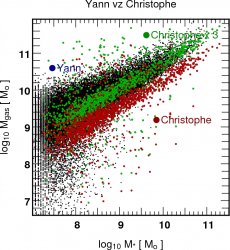 Yann’s & Chris’s Mstar vz Mgas
The discrepency arises because of a different choice in outer radius.
|
Cosmic SFH,Color, metals, density, SFR confrontation with data
| | |
Satellite accretion efficiency
Here we compute the fraction of the surface of the (rescaled) adaphop mother radius which is covered by satellites.
Star Formation rate
Genus (Euler Characteristic)
TODOs:
![]() Two point correlation in redshift-real space for stars as a function
of luminosity.
Two point correlation in redshift-real space for stars as a function
of luminosity.
![]() Section of filaments gas/DM;
Section of filaments gas/DM;
![]() Spectra and slices with metals species.
Spectra and slices with metals species.
![]() Accretion flow maps;
Accretion flow maps;
![]() Redshift evolution;
Redshift evolution;
![]() Mass profiles;
Mass profiles;
![]() phase space morphology segmentation and NN classification
phase space morphology segmentation and NN classification
![]() Redshift distorsion
Redshift distorsion
![]() Pk multiscale
Pk multiscale
![]() feeding factor.
feeding factor.

